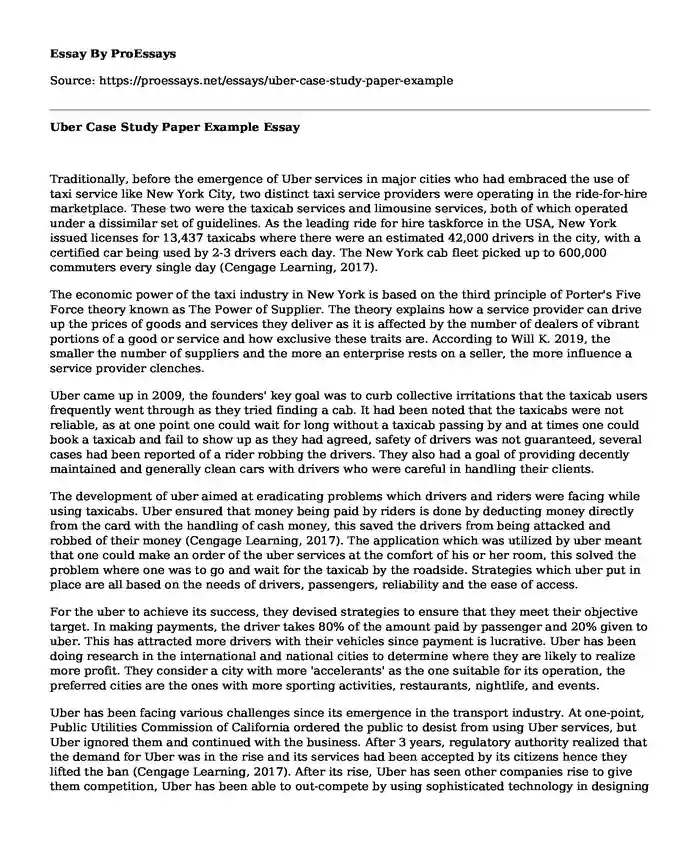Traditionally, before the emergence of Uber services in major cities who had embraced the use of taxi service like New York City, two distinct taxi service providers were operating in the ride-for-hire marketplace. These two were the taxicab services and limousine services, both of which operated under a dissimilar set of guidelines. As the leading ride for hire taskforce in the USA, New York issued licenses for 13,437 taxicabs where there were an estimated 42,000 drivers in the city, with a certified car being used by 2-3 drivers each day. The New York cab fleet picked up to 600,000 commuters every single day (Cengage Learning, 2017).
The economic power of the taxi industry in New York is based on the third principle of Porter's Five Force theory known as The Power of Supplier. The theory explains how a service provider can drive up the prices of goods and services they deliver as it is affected by the number of dealers of vibrant portions of a good or service and how exclusive these traits are. According to Will K. 2019, the smaller the number of suppliers and the more an enterprise rests on a seller, the more influence a service provider clenches.
Uber came up in 2009, the founders' key goal was to curb collective irritations that the taxicab users frequently went through as they tried finding a cab. It had been noted that the taxicabs were not reliable, as at one point one could wait for long without a taxicab passing by and at times one could book a taxicab and fail to show up as they had agreed, safety of drivers was not guaranteed, several cases had been reported of a rider robbing the drivers. They also had a goal of providing decently maintained and generally clean cars with drivers who were careful in handling their clients.
The development of uber aimed at eradicating problems which drivers and riders were facing while using taxicabs. Uber ensured that money being paid by riders is done by deducting money directly from the card with the handling of cash money, this saved the drivers from being attacked and robbed of their money (Cengage Learning, 2017). The application which was utilized by uber meant that one could make an order of the uber services at the comfort of his or her room, this solved the problem where one was to go and wait for the taxicab by the roadside. Strategies which uber put in place are all based on the needs of drivers, passengers, reliability and the ease of access.
For the uber to achieve its success, they devised strategies to ensure that they meet their objective target. In making payments, the driver takes 80% of the amount paid by passenger and 20% given to uber. This has attracted more drivers with their vehicles since payment is lucrative. Uber has been doing research in the international and national cities to determine where they are likely to realize more profit. They consider a city with more 'accelerants' as the one suitable for its operation, the preferred cities are the ones with more sporting activities, restaurants, nightlife, and events.
Uber has been facing various challenges since its emergence in the transport industry. At one-point, Public Utilities Commission of California ordered the public to desist from using Uber services, but Uber ignored them and continued with the business. After 3 years, regulatory authority realized that the demand for Uber was in the rise and its services had been accepted by its citizens hence they lifted the ban (Cengage Learning, 2017). After its rise, Uber has seen other companies rise to give them competition, Uber has been able to out-compete by using sophisticated technology in designing its application and they charge their clients fairly.
Entry of Uber into the market has noted tremendous success, this is attributed to the good leadership it has and favorable policies which the company enforces. Drivers who own vehicles have been able to join the system of Uber thus making a profit. Uber has brought benefits to both drivers and passengers. The passenger can request for Uber services anywhere using Uber app thus saving them from the need to walk for a distance before getting taxi services.
Conclusion
In conclusion, Uber have experienced tremendous development and expansion since its inception. In 2013, Uber had revenue of $125 million. With the deployment of good marketing strategies and research done before starting uber service in a city, profit has been registered annually hence it is expected that Uber will keep on expanding its services to other countries.
References
Cengage Learning. (2017). The Ride for Hire Market Place in United States. Case 17 Uber: Driving Global Distribution, 107-116.
Cite this page
Uber Case Study Paper Example. (2022, Dec 05). Retrieved from https://proessays.net/essays/uber-case-study-paper-example
If you are the original author of this essay and no longer wish to have it published on the ProEssays website, please click below to request its removal:
- The Chinese Law Reform and Its Effect on the Australian Business
- Summary of Carr's Argument "Is Business Bluffing Ethical?"
- Assets and Liabilities of Apple Inc Essay
- Paper Example on Business Legal Issues
- Ethical Concerns Affect the Role of Business in Society Essay Example
- Essay Sample on Business Ethics: Understanding why it Matters from a Manager's Point of View
- Successful Entrepreneurship: Reflections on Program Design & Behaviour - Essay Sample







